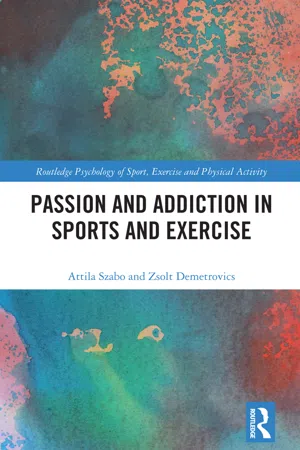
Passion and Addiction in Sports and Exercise
Attila Szabo, Zsolt Demetrovics
- 240 pages
- English
- ePUB (mobile friendly)
- Available on iOS & Android
Passion and Addiction in Sports and Exercise
Attila Szabo, Zsolt Demetrovics
About This Book
Passion and Addiction in Sports and Exercise is about the bright and dark aspects of sports and exercise behavior and revolves around two closely related yet distinct concepts. Passion is a joyful and healthy reflection of one's enjoyment and dedication to an adopted sport or exercise. At the same time, exercise addiction is an obligatory and must-be-done training regimen. This book is the first to attempt to explain the significant differences between passion and addiction in sports and exercise, as well as the relationship between the two.
This book presents an overview of three dimensions of passion and offers a new frame to contextualize exercise addition. The work also addresses the misinterpretation of certain aspects of training (e.g., intensity, frequency, and commitment) often related to the risk of exercise addiction. After introducing the health benefits of exercise, the book looks at the passion for sports and exercise training and the transition into maladaptive practice. Then it presents definitions and theoretical models for exercise addiction. It then examines exercise addiction cases while also illustrating how excessive or high exercise volumes could be beneficial instead of problematic. The last chapter offers a new approach for a better understanding of exercise addiction.
Passion and Addiction in Sports and Exercise is helpful for students, researchers, and clinicians interested in sport and exercise psychology, athletic training, behavioral addictions, and physical education. As well as being valuable reading for all regular exercisers and physically active individuals, including athletes competing at various levels in different sport disciplines.
Frequently asked questions
Information
1 Sports and exercise for healthy living
1.1 The need for physical activity today

1.2 The role of regular physical activity in health
Table of contents
- Cover
- Half Title
- Series
- Title
- Copyright
- Dedication
- Contents
- List of figures
- List of tables
- Foreword
- Acknowledgments
- 1 Sports and exercise for healthy living
- 2 Passion: definitions and conceptualization
- 3 Passion in athletes and leisure exercisers
- 4 Runner’s high: a path from healthy to dysfunctional exercise?
- 5 Behavioral addictions: overview and classifications
- 6 Uncovering exercise addiction: a historical perspective
- 7 Commitment versus addiction in sports and exercise
- 8 Psychological manifestations of exercise deprivation
- 9 Exercise addiction: definition and conceptualization
- 10 Primary and secondary forms of exercise dependence
- 11 Psychophysiological models for exercise addiction
- 12 Psychometric assessment of exercise addiction
- 13 Undiagnosed but real cases of exercise addiction
- 14 Is exercise addiction a symptom or a disorder?
- 15 Treatment of exercise addiction
- 16 Untangling passion from exercise addiction: shaping the knowledge
- 17 Novel conceptualization of passion and addiction is sport and exercise
- Index